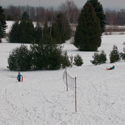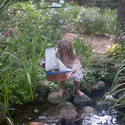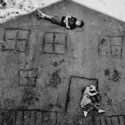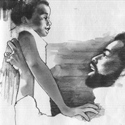 Saw a couple of high school friends over the weekend, went to a few hometown bars where we hoped we wouldn't run into anyone else we knew from the dark old days. As we took the first sips of a fourth round of pints, one of us mentioned how none of us ever drank in high school.
Saw a couple of high school friends over the weekend, went to a few hometown bars where we hoped we wouldn't run into anyone else we knew from the dark old days. As we took the first sips of a fourth round of pints, one of us mentioned how none of us ever drank in high school.
"What was wrong with us?"
"What did we do then?"
But we knew. Unlike normal, decent kids who got wasted at some house whenever someone else's parents were in Aspen or Acapulco, we were out causing real trouble: trespassing, jumping from rooftop to rooftop downtown, violating any number of other local ordinances. I spent nights in police stations. I was frisked more than once. "Remember that time you jumped out of Steve's jeep after he drove up that giant sand dune behind the Budweiser plant?" I asked one friend. "We chased you home with Steve shining that police spotlight on you the whole time."
"You assholes said I looked like a Yeti."
But more than anything else, back then we broke into abandoned buildings. There was the ghost town out in the country, the abandoned tuberculosis asylum down by the cemetery, the vacant churches, the shuttered paper mills. We'd bring girls with us sometimes, and they'd stay close, hide their eyes in our shoulders, their frightened breath on our necks. When one of us couldn't round up a girl, we'd go out ahead of time and wait alone for our friends to show up, ready to terrify them with stomping footsteps and rattling chains. I remember the feeling of being alone in those damp, echoing places, the cold silence of the long-vacated morgue, its steel corpse drawers haphazardly opened and closed. I remember the smell of ancient wine spilled from casks stored in the back of the old hotel, where there was an open door facing away from the road and where, terrified, we'd burst out into air that smelled like the mint growing wild in the fields. The ghost town had once boomed providing mint to William Wrigley. The town had died, but we went there to feel alive.
Detroit, with its thousands of abandoned structures, is something of a mecca for kids and adults who still do this sort of thing. There's a whole community of them here, and people come from all over the country to "explore" the city's ruins. In the little I've done since we moved here I haven't found that same adolescent thrill. Maybe because I no longer need to terrify girls to get them to come close to me. Or maybe the whole thing just seems so hackneyed because there are so many people doing it here. My photographs of these buildings seem so clichéd, so easily sentimental. There have been moments where I have been awed, like the eve of this past Thanksgiving, when I finally wandered into the darkness of the Michigan Central Station, a Beaux-Arts masterpiece designed by the same firm as New York's Grand Central, but abandoned to the mercy of the elements, architectural scavengers, vandals, and graffiti taggers. To visit and photograph this building again is something of a cliché in urban exploration, as it ranks high among the greatest modern ruins in the world. It is our Parthenon, our Colosseum. Yet in the stillness of the early evening, with rain dripping everywhere through its tattered roof, and darkness slowly swallowing the faded, almost-unfathomable grandiosity of the waiting room, it was not hard to get lost in the sublime. I was alone in there (as far as I knew), and the darkness and giant Doric columns allowed logic itself to bend. I saw things I will not admit to you. It was terrifying and highly satisfying.
But trespassing across the road, I experienced something else entirely. Because of the response to the photos I put on flickr of the abandoned Detroit Public Schools Book Depository, I went back again to take some more with a better lens in HDR (blending different exposures): This is a building where our deeply-troubled public school system once stored its supplies, and then one day apparently walked away from it all, allowing everything to go to waste. The interior has been ravaged by fires and the supplies that haven't burned have been subjected to 20 years of Michigan weather. To walk around this building transcends the sort of typical ruin-fetishism and "sadness" some get from a beautiful abandoned building. This city's school district is so impoverished that students are not allowed to take their textbooks home to do homework, and many of its administrators are so corrupt that every few months the newspapers have a field day with their scandals, sweetheart-deals, and expensive trips made at the expense of a population of children who can no longer rely on a public education to help lift them from the cycle of violence and poverty that has made Detroit the most dangerous city in America. To walk through this ruin, more than any other, I think, is to obliquely experience the real tragedy of this city; not some sentimental tragedy of brick and plaster, but one of people:
This is a building where our deeply-troubled public school system once stored its supplies, and then one day apparently walked away from it all, allowing everything to go to waste. The interior has been ravaged by fires and the supplies that haven't burned have been subjected to 20 years of Michigan weather. To walk around this building transcends the sort of typical ruin-fetishism and "sadness" some get from a beautiful abandoned building. This city's school district is so impoverished that students are not allowed to take their textbooks home to do homework, and many of its administrators are so corrupt that every few months the newspapers have a field day with their scandals, sweetheart-deals, and expensive trips made at the expense of a population of children who can no longer rely on a public education to help lift them from the cycle of violence and poverty that has made Detroit the most dangerous city in America. To walk through this ruin, more than any other, I think, is to obliquely experience the real tragedy of this city; not some sentimental tragedy of brick and plaster, but one of people:

 Pallet after pallet of mid-1980s Houghton-Mifflin textbooks, still unwrapped in their original packaging, seem more telling of our failures than any vacant edifice. The floor is littered with flash cards, workbooks, art paper, pencils, scissors, maps, deflated footballs and frozen tennis balls, reel-to-reel tapes. Almost anything you can think of used in the education of a child during the 1980s is there, much of it charred or rotted beyond recognition. Mushrooms thrive in the damp ashes of workbooks. Ailanthus altissima, the "ghetto palm" grows in a soil made by thousands of books that have burned, and in the pulp of rotted English Textbooks. Everything of any real value has been looted. All that's left is an overwhelming sense of knowledge unlearned and untapped potential. It is almost impossible not to see all this and make some connection between the needless waste of all these educational supplies and the needless loss of so many lives in this city to poverty and violence, though the reality of why these supplies were never used is unclear. *[see update below]* In some breathtakingly-beautiful expression of hope, an anonymous graffiti artist has painted a phoenix-like book rising from the ashes of the third floor.
Pallet after pallet of mid-1980s Houghton-Mifflin textbooks, still unwrapped in their original packaging, seem more telling of our failures than any vacant edifice. The floor is littered with flash cards, workbooks, art paper, pencils, scissors, maps, deflated footballs and frozen tennis balls, reel-to-reel tapes. Almost anything you can think of used in the education of a child during the 1980s is there, much of it charred or rotted beyond recognition. Mushrooms thrive in the damp ashes of workbooks. Ailanthus altissima, the "ghetto palm" grows in a soil made by thousands of books that have burned, and in the pulp of rotted English Textbooks. Everything of any real value has been looted. All that's left is an overwhelming sense of knowledge unlearned and untapped potential. It is almost impossible not to see all this and make some connection between the needless waste of all these educational supplies and the needless loss of so many lives in this city to poverty and violence, though the reality of why these supplies were never used is unclear. *[see update below]* In some breathtakingly-beautiful expression of hope, an anonymous graffiti artist has painted a phoenix-like book rising from the ashes of the third floor.
This building is not far at all from the Michigan Central Station. Its exterior boasts no Corinthian columns, no real ornament to speak of. Unlike the station, it is squat and quite unremarkable. Suburban teens and even adults often ignore it as they regularly break into the station to leave their talentless tags, thrill at the decay, or just stand in awe of the colossal space inside. Their grandparents might have first set foot in Detroit at that station, stepping off trains from back east or down south. It was built with the sort of opulence that signified great promise for anyone who passed through it. Peasants from Poland or Alabama would have been awed by it all, but could hardly have realized that their great-grandchildren would one day leave their names upon its crumbling columns, binding themselves in that way to those same stones as though it were a promise kept.
When I post pictures of Detroit, I am always struck by the way people respond in the comments with a sense of "sadness." The reactions we have to ruins is something that fascinates me, and I'd love to hear more in the comments about how you feel looking at such buildings or even just seeing the photos I post on flickr. Of course, I sometimes share a sense of sadness, but still I wonder: why is it "sad" for a building to be left to decay if there is no one willing to use it? Can decay be something more than sentimental? Can it ever be beautiful? Can it just be respected for what it is, and not further corrupted by our emotions? And what is it that draws us to ruination? Why do some of us find it so compelling? I'd like to believe I am much more saddened by people whose lives fall apart than I am by crumbling stones or plaster. Sadly, social decay is just so much more easy to ignore, and not as prettily exposed with the lens of a camera.
Unless, that is, you stumble upon a warehouse full of abandoned hope. Walking back home from the book depository that day, I stopped to talk to the homeless men who live in Roosevelt Park. They told me they see people like me going into the station every day. I assumed by "like me" they meant bourgeois whites carrying tripods and DSLR cameras. The next time I went, I saw a few dozen more homeless men and women receiving handouts from some mobile charity, directly in the shadow of the train station. Some of them have made homes inside these ruins. They carried bottles covered with paper bags. They seemed almost giddy, happy just to eat something warm. I thought of the lovers in Robert Browning's poem. I thought of the paintings I'd seen earlier that week at the Detroit Institute of Arts, of medieval peasants frolicking amid the ruins of Ancient Rome.
Cows once grazed in the forum. And rich men who are long dead once decorated their walls with scenes not so different from this.
[*update* I have done some research about what actually happened at the book depository/Roosevelt Warehouse and post about it here]
Copyright © 2005-2016 Sweet Juniper Media, Inc.
All Rights Reserved.
All Rights Reserved.
"Sweet Juniper" is a registered trademark.
No unauthorized reuse.
No unauthorized reuse.
Categories
- Friday Morning Street Urchin Blogging ( 107 )
- Detroit ( 60 )
- SAHD ( 34 )
- photography ( 30 )
- Thursday Morning Wood ( 25 )
- Halloween ( 23 )
- Thrift ( 18 )
- abandoned places ( 18 )
- terrifying nixon-era children's books ( 16 )
- Reminiscin' ( 15 )
- Sweet Juniper Media ( 11 )
- Wendell ( 10 )
- Design ( 9 )
- San Francisco ( 9 )
- nature fights back ( 9 )
- sleep ( 9 )
- if you ain't dutch you ain't much ( 8 )
- sentimental ( 7 )
- Music ( 6 )
- Parody ( 6 )
- birth story ( 6 )
- scrappers ( 6 )
- Sweet Juniper Tunes ( 5 )
- lawyering ( 5 )
- Zoo ( 4 )
- elegant leisure ( 4 )
- language ( 3 )
- feral houses ( 2 )
- theme parks of the damned ( 2 )
- zombies ( 1 )
Archives
- November 2017 ( 2 )
- December 2016 ( 1 )
- November 2016 ( 2 )
- December 2015 ( 1 )
- November 2015 ( 2 )
- December 2014 ( 1 )
- October 2014 ( 2 )
- April 2014 ( 1 )
- December 2013 ( 2 )
- November 2013 ( 1 )
- October 2013 ( 1 )
- September 2013 ( 2 )
- July 2013 ( 2 )
- June 2013 ( 1 )
- April 2013 ( 1 )
- March 2013 ( 3 )
- February 2013 ( 1 )
- January 2013 ( 1 )
- December 2012 ( 2 )
- November 2012 ( 1 )
- October 2012 ( 4 )
- September 2012 ( 2 )
- August 2012 ( 2 )
- July 2012 ( 1 )
- June 2012 ( 3 )
- May 2012 ( 1 )
- April 2012 ( 2 )
- March 2012 ( 1 )
- February 2012 ( 2 )
- January 2012 ( 1 )
- December 2011 ( 3 )
- November 2011 ( 3 )
- October 2011 ( 5 )
- September 2011 ( 3 )
- August 2011 ( 4 )
- July 2011 ( 4 )
- June 2011 ( 2 )
- May 2011 ( 4 )
- April 2011 ( 6 )
- March 2011 ( 7 )
- February 2011 ( 4 )
- January 2011 ( 4 )
- December 2010 ( 5 )
- November 2010 ( 7 )
- October 2010 ( 5 )
- September 2010 ( 4 )
- August 2010 ( 5 )
- July 2010 ( 7 )
- June 2010 ( 5 )
- May 2010 ( 5 )
- April 2010 ( 5 )
- March 2010 ( 4 )
- February 2010 ( 5 )
- January 2010 ( 5 )
- December 2009 ( 6 )
- November 2009 ( 5 )
- October 2009 ( 8 )
- September 2009 ( 9 )
- August 2009 ( 6 )
- July 2009 ( 9 )
- June 2009 ( 8 )
- May 2009 ( 8 )
- April 2009 ( 8 )
- March 2009 ( 12 )
- February 2009 ( 11 )
- January 2009 ( 9 )
- December 2008 ( 11 )
- November 2008 ( 9 )
- October 2008 ( 14 )
- September 2008 ( 11 )
- August 2008 ( 11 )
- July 2008 ( 12 )
- June 2008 ( 10 )
- May 2008 ( 9 )
- April 2008 ( 8 )
- March 2008 ( 10 )
- February 2008 ( 15 )
- January 2008 ( 12 )
- December 2007 ( 9 )
- November 2007 ( 12 )
- October 2007 ( 11 )
- September 2007 ( 13 )
- August 2007 ( 11 )
- July 2007 ( 8 )
- June 2007 ( 12 )
- May 2007 ( 10 )
- April 2007 ( 10 )
- March 2007 ( 12 )
- February 2007 ( 14 )
- January 2007 ( 12 )
- December 2006 ( 11 )
- November 2006 ( 10 )
- October 2006 ( 13 )
- September 2006 ( 8 )
- August 2006 ( 13 )
- July 2006 ( 13 )
- June 2006 ( 15 )
- May 2006 ( 13 )
- April 2006 ( 9 )
- March 2006 ( 10 )
- February 2006 ( 3 )
- January 2006 ( 5 )
- December 2005 ( 2 )
- November 2005 ( 8 )
- October 2005 ( 4 )
- September 2005 ( 1 )
- July 2005 ( 3 )


























